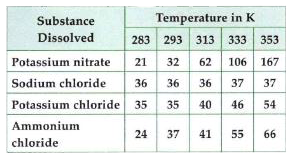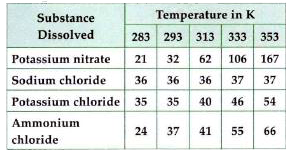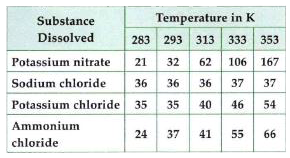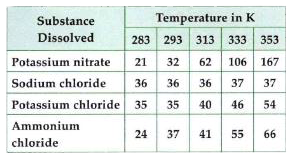Pragya tested the solubility of three different substances at different temperatures and collected the data as given below (results are given in the following table, as grams of substance dissolved in 100 grams of water to form a saturated solution).

(a) What mass of potassium nitrate would be needed to produce a saturated solution of potassium nitrate in 50 grams of water at 313 K ?
(b) Pragya makes a saturated solution of potassium chloride in water at 353 K and leaves the solution to cool at room temperature. What would she observe as the solution cools ? Explian.
(c ) Find the solubility of each salt at 293 K . Which salt has the highest solubility at this temperature ?
(d) What is the effect of change of temperature on the solubility of a salt ?
(a) At 313 K, in the saturated solution
Amount of potassium nitrate dissolved in 100 grams of water = 62 g
Amount of potassium nitrate dissolved in 50 grams of water = (62 g) ×(50g)(100g)=31g
(b) When the saturated solution prepared at 353 K is cooled to room temperature (about 298 K) the solubility of potassium chloride in water will decrease. It will slowly start separating as a crystalline white residue at the bottom of the container.
(c ) The solubility of the salt in a water is defined as :
the maximum amount of the salt which is dissolved in 100 g of water (or any other solvent) to form a saturated solution at a given temperature
In the light of this, at 293 K
Solubility of potassium nitrate = 32 g per 100 g of water
Solubility of sodium chloride = 36 g per 100 g of water
Solubility of potassium chloride = 35 g per 100 g of water
Solubility of ammonium chloride = 37 g per 100 g of water
Ammonium chloride has the maximum solubility (37 g per 100 g of water) at 293 K
(d) With rise in temperature, the solubility of all the salts in water increases. This has been shown by the data given in the table. Similarly, when the temperature is decreased, the solubility of these salts in water decreases.
Topper's Solved these Questions
- IS MATTER AROUND US PUREBOOK - DINESH PUBLICATIONCHAPTER - IS MATTER AROUND US PUREEXERCISE - Very Short Answer Questions
58 Videos
- IS MATTER AROUND US PUREBOOK - DINESH PUBLICATIONCHAPTER - IS MATTER AROUND US PUREEXERCISE - Short Answer Questions
58 Videos
- IS MATTER AROUND US PUREBOOK - DINESH PUBLICATIONCHAPTER - IS MATTER AROUND US PUREEXERCISE - LAQs
10 Videos
- ATOMS AND MOLECULESBOOK - DINESH PUBLICATIONCHAPTER - ATOMS AND MOLECULESEXERCISE - LONG ANSWER QUESTIONS
24 Videos
- MATTER IN OUR SURROUNDINGS BOOK - DINESH PUBLICATIONCHAPTER - MATTER IN OUR SURROUNDINGS EXERCISE - (LAQs) Long Answer Questions
5 Videos
Similar Questions
Pragya tested the solubility of three different substances at different temperatures and collected the data as given below (results are given in the following table, as grams of substance dissolved in 100 grams of water to form a saturated solution).

What mass of potassium nitrate would be needed to produce a saturated solution of potassium nitrate in 50 grams of water at 313 K?
View SolutionPargya tested the solubility of four different substances at different temperatures and collected the data as given below (results are given in the following table as grams of substance dissolved in 100 grams of water to from a saturated solutin).

(a) What mass of potassium nitrate would be needed to procuce a strurated solution of potassium nitrate in 50 grams of water at 313 K ?
(b) Pragya makes a saturated solution of potassium chloride in water at 353 K and leaves the solution to cool at room temperature. What would she observe as the solution cools ? Explain.
(c ) Find the solubility of each salt at 293 K. Which salt has the highest solubility at this twmperature?
(d) What is the effect of change in temperature on the solubility of a salt ?
View Solution
Knowledge Check
0.1 gram mole of urea dissolved in 100 g of water. The molality of the solution is
A1 mB0.01 MC0.01 mD1.0 M10 grams of a solute is dissolved in 90 grams of a solvent. Its mass percent in solution is
A0.01B11.1C10D9
Pragya tested the solubility of three different substances at different temperatures and collected the data as given below (results are given in the following table, as grams of substance dissolved in 100 grams of water to form a saturated solution).

What is the effect of change of temperature on the solubility of a salt?
View SolutionPragya tested the solubility of three different substances at different temperatures and collected the data as given below (results are given in the following table, as grams of substance dissolved in 100 grams of water to form a saturated solution).

Find the solubility of each salt at 293 K. Which salt has the highest solubility at this temperature?
View SolutionPragya tested the solubility of three different substances at different temperatures and collected the data as given below (results are given in the following table, as grams of substance dissolved in 100 grams of water to form a saturated solution).

Pragya makes a saturated solution of potassium chloride in water at 353 K and leaves the solution to cool at room temperature. What would she observe as the solution cools? Explain.
View SolutionSolubility of KNO3at 313 K is 62 g. What mass of KNO3 would be needed to produce a saturated solution of KNO3 in 50 g of water at 313 K ?
View Solution4 g of a solute are dissolved in 40 g of water to form a saturated solution at 25∘C. Calculate the solubility of the solute.
View SolutionA student , determined the solubility of four substabces ,potassium nitrate ,sodium , sodim choride ,potassium choride and ammonium choride in a water at five different temperatures of 10∘C,20∘(C40∘C,60∘C and 80∘C and obtained the following data :

(a) what mass of potassium nitrate woulds be needed to make a satured solution of potassium nitrate in 50 grams of water at 40∘C? (b) what would be observed if a saturated solution of potassium choride at 80∘C is left to cool to the room temperature ?
( c) what is the solubilty of each salt at 20∘C ? which salt has the highest solubility at this temperature ?
(d) what is the effect of change of temperature on the solbubility of a salt as shown by the above date?
View Solution
